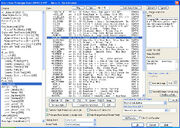In BiaB, styles refer to musical styles encapsulated in style files (*.STY). There are thousands of styles included with most BiaB installations. Styles can be midi only, a combination of midi and RealTracks/Drums or RealTrack/Drums only (called RealStyles). ###################
Style picker[]

Style Picker Dialog
BiaB includes a style picker dialog to help organize all these files into catagories. The Style Picker is organised into categories and styles within the selected category.
Many styles have notes in the memo box regarding the content of the styles. In addition there is an examples box listing artists and songs the selected style would work with.
Users can enter styles into the favorites category to make it easier to find them. You can create .LS3 files to add information to the style picker. Instructions are in the user manual.
Information about styles you make yourself is stored in a file called A_USER.LS3. This is a text file, but it is better to edit it using the StylePicker editor. You can make other .LS3 files using the StylePicker editor, using the Save As and Open buttons. You can also erase an .LS3 file from disk. Third party added styles are also stored in .LS3 files. Band-in-a-Box will load in all of the .LS3 files that are in the \bb folder (in alphabetical order), and append them to the StylePicker list.[1]
Style File Prefixes[]
We use the term RealStyles to describe Styles (That is, .STY files that you choose from the StylePicker) that are composed entirely of RealTracks instruments and have no MIDI parts. The convention we've been using is to use an underscore prefix for these styles. For example _MyStyle.sty is a RealStyle. There is a category in the StylePicker that contains only RealStyles, so you can browse through styles without ever hearing MIDI. We use the = (equal sign) prefix for styles that have some MIDI parts, but at least one RealTracks instrument. The - (hyphen) prefix was used for styles that have RealDrums embedded while the rest of the tracks are MIDI.[2]
The naming convention for MultiStyles is to use a + sign at the end of the style name. For example, MyStyle+.STY would be a MultiStyle.
If the prefix of the style is the # symbol, it is a Norton Music Style http://www.nortonmusic.com. Back in 1992 Peter Gannon asked me to pick a letter or symbol to start my styles with. He said that he would not write any styles with the same letter or symbol and that way our styles won't over-write each other. I picked the # sign because it looks like the music sharp.
.
User Created Styles[]
Users can create their own styles in Band in a Box. The simplest method is to create a hybrid style. Another method is to import a style from a MIDI file, Finally, a user can create a style using the StyleMaker.
Substyles[]
Band in a Box styles usually consist of two substyles. These are defined in the style file (*.sty). On the chord sheet these substyles are indicated by the part markers for the 'a' part (blue) and 'b' part (green). Clicking a bar number will select in sequence the blue 'a' part, the green 'b' part and finally return to no substyle.
The 'a' substyle is usually used for chorus parts and the 'b' substyle is usually used for bridges. The 'b' part is usually somewhat 'busier' and may have changes such as the addition of a ride cymbal.
Note that adding a part marker will automatically generate a drum fill in the preceding bar, so selecting the same substyle as that already in effect will insert a fill without changing substyles.
Norton Music invented "Mix and Match" styles to enable the user to have 4 substyles (A, B, C and D). A couple of years later PG Music joined in and created Multi-Styles. You can listen to mp3 demos of the "Mix and Match" styles here http://www.nortonmusic.com/styledemo.html
MultiStyles[]
Band-in-a-Box MultiStyles are styles that can have up to 24 substyles; original Band-in-a-Box styles had two substyles, “a” and “b.” Band-in-a-Box MultiStyles typically have four substyles, but may have up to twenty-four, selected by using part markers “a” through “x.” You can easily make your own MultiStyles, either from scratch, or combining parts from existing styles to make a MultiStyle. For example, if you have 10 favorite Country styles, you can quickly make a single MultiStyle that has 20 substyles available within the same song.[3]
To make a MultiStyle stored to disk as a .STY file all the pairs of substyles must already exist as independant .STY files. For example, if you want a style with 4 parts, 'a', 'b', 'c' and 'd' called MyRock (on disk as MyRock+.STY) the four parts need to exist as precreated styles. Suppose you like the ZZMEDROK style for the 'a' and 'b' parts and ZZLITROK for the 'c' and 'd' parts. You could combine these two styles into your MyRock MultiStyle.
Open ZZMEDROK in the StyleMaker and press the Misc button. In the MultiStyles group box, type the name of a style that you would like to use for the c/d section (ZZLITROK). Then Save the style under the name MyRock+.STY. Now when you select MyRock as a song style you will have access to four substyles.
3rd Party Styles[]
There are many 3rd party styles available, both free and for purchase, to enhance Band in a Box.
You can get aftermarket styles and songs by Bob "Notes" Norton, Roy Hawkesford, David Bailey, and Sherry Mayrent at http://www.nortonmusic.com